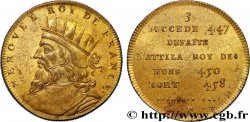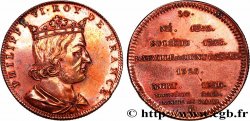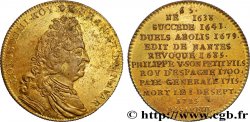E-auction 547-473513 - fme_861562 - SÉRIE MÉTALLIQUE DES ROIS DE FRANCE Médaille, François Ier
Чтобы принять участие в торгах, вы должны войти в систему и стать подтвержденным участником аукциона. Войдите, чтобы сделать ставку. Ваш аккаунт будет подтвержден в течение 48 часов. Не ждите до закрытия торгов, чтобы зарегистрироваться.Сделав ставку на данный товар, вы вступаете в юридическое соглашение на покупку выбранного товара и нажатием кнопки «Сделать ставку» подтверждаете принятие вами условий интернет-аукционов cgb.fr.
Ставка может бить сделана только в полном эквиваленте евро. Торги закроются согласно времени, указанному в описании товара, все ставки, сделанные после закрытия торгов, учитываться не будут. Не следует откладывать предложение вашей ставки до последнего момента, так как система может не успеть обработать вашу заявку, и ваша ставка не будет принята. Более детальную информацию вы найдёте здесь: FAQ по интернет-аукционам.
БЕСПЛАТНО.
БЕСПЛАТНО.
| Оценить : | 15 € |
| Цена : | 3 € |
| Максимальная предлагаемая цена : | 4 € |
| Конец торгов : | 09 October 2023 19:44:20 |
| Участников : | 2 Участников |
Тип Médaille, François Ier
Дата: n.d.
Металл: copper nickel
Диаметр: 33 mm
Ориентация осей монеты: 12 h.
Вес: 21 g.
Век: Cannelée
Пуансон: corne d’abondance
Редкость: R2
Комментарии о состоянии
Quelques coups et rayures
Лицевая сторона
Аверс: легенда: FRANCOIS I ROY DE FRANCE..
Аверс: описание: Buste couronné à gauche.
Обратная сторона
Реверс: легенда: 58. / NÉ 1494. / SUCCEDE 1515. / RETABLISSEMENT / DES SCIENCES ET DES / BEAUX ARTS. / MORT. 1547. / TROISIEME RACE. / P..
Реверс: Описание: Légende en huit lignes.
Комментарий
Refrappe ultra-moderne des séries de jetons.
François Ier (1494 – 1547), dit le Père et Restaurateur des Lettres, le Roi Chevalier, le Roi Guerrier, le Grand Colas, le Bonhomme Colas ou encore François au Grand Nez, est sacré roi de France le 25 janvier 1515 dans la cathédrale de Reims, et règne jusqu’à sa mort en 1547. Fils de Charles d’Angoulême et de Louise de Savoie, il appartient à la branche de Valois-Angoulême de la dynastie capétienne.
François Ier est considéré comme le monarque emblématique de la période de la Renaissance française[2]. Son règne permet un développement important des arts et des lettres en France. Sur le plan militaire et politique, le règne de François Ier est ponctué de guerres et d’importants faits diplomatiques.
Il a un puissant rival en la personne de Charles Quint et doit compter sur les intérêts diplomatiques du roi Henri VIII d’Angleterre toujours désireux de se positionner en allié de l’un ou l’autre camp. François Ier enregistre succès et défaites mais interdit à son ennemi impérial de concrétiser ses rêves, dont la réalisation toucherait l’intégrité du royaume. L'antagonisme des deux souverains catholiques a de lourdes conséquences pour l’Occident chrétien: il facilite la diffusion de la Réforme naissante et surtout permet à l'Empire ottoman de s'installer aux portes de Vienne en s'emparant de la quasi-totalité du royaume de Hongrie.
Pour la suite de sa biographie, voir http://fr.wikipedia.org/wiki/Fran%C3%A7ois_Ier_de_France.
Ultra-modern re-minting of token series.
Francis I (1494 – 1547), known as the Father and Restorer of Letters, the Knight King, the Warrior King, the Great Colas, the Good Man Colas or Francis with the Big Nose, was crowned King of France on January 25, 1515 in the cathedral of Reims, and reigned until his death in 1547.. Son of Charles of Angoulême and Louise of Savoy, he belongs to the Valois-Angoulême branch of the Capetian dynasty.
Francis I is considered the emblematic monarch of the French Renaissance period[2]. His reign allowed for significant development of the arts and literature in France. On the military and political level, the reign of François I was punctuated by wars and important diplomatic events..
He has a powerful rival in the person of Charles V and must count on the diplomatic interests of King Henry VIII of England, always eager to position himself as an ally of one camp or the other.. Francis I recorded successes and defeats but forbade his imperial enemy from realizing his dreams, the realization of which would affect the integrity of the kingdom.. The antagonism between the two Catholic sovereigns had serious consequences for the Christian West: it facilitated the spread of the nascent Reformation and, above all, allowed the Ottoman Empire to establish itself at the gates of Vienna, seizing almost the entire Kingdom of Hungary..
For the rest of his biography, see http://fr. Wikipedia. org/wiki/Fran%C3%A7ois_Ier_de_France
François Ier (1494 – 1547), dit le Père et Restaurateur des Lettres, le Roi Chevalier, le Roi Guerrier, le Grand Colas, le Bonhomme Colas ou encore François au Grand Nez, est sacré roi de France le 25 janvier 1515 dans la cathédrale de Reims, et règne jusqu’à sa mort en 1547. Fils de Charles d’Angoulême et de Louise de Savoie, il appartient à la branche de Valois-Angoulême de la dynastie capétienne.
François Ier est considéré comme le monarque emblématique de la période de la Renaissance française[2]. Son règne permet un développement important des arts et des lettres en France. Sur le plan militaire et politique, le règne de François Ier est ponctué de guerres et d’importants faits diplomatiques.
Il a un puissant rival en la personne de Charles Quint et doit compter sur les intérêts diplomatiques du roi Henri VIII d’Angleterre toujours désireux de se positionner en allié de l’un ou l’autre camp. François Ier enregistre succès et défaites mais interdit à son ennemi impérial de concrétiser ses rêves, dont la réalisation toucherait l’intégrité du royaume. L'antagonisme des deux souverains catholiques a de lourdes conséquences pour l’Occident chrétien: il facilite la diffusion de la Réforme naissante et surtout permet à l'Empire ottoman de s'installer aux portes de Vienne en s'emparant de la quasi-totalité du royaume de Hongrie.
Pour la suite de sa biographie, voir http://fr.wikipedia.org/wiki/Fran%C3%A7ois_Ier_de_France.
Ultra-modern re-minting of token series.
Francis I (1494 – 1547), known as the Father and Restorer of Letters, the Knight King, the Warrior King, the Great Colas, the Good Man Colas or Francis with the Big Nose, was crowned King of France on January 25, 1515 in the cathedral of Reims, and reigned until his death in 1547.. Son of Charles of Angoulême and Louise of Savoy, he belongs to the Valois-Angoulême branch of the Capetian dynasty.
Francis I is considered the emblematic monarch of the French Renaissance period[2]. His reign allowed for significant development of the arts and literature in France. On the military and political level, the reign of François I was punctuated by wars and important diplomatic events..
He has a powerful rival in the person of Charles V and must count on the diplomatic interests of King Henry VIII of England, always eager to position himself as an ally of one camp or the other.. Francis I recorded successes and defeats but forbade his imperial enemy from realizing his dreams, the realization of which would affect the integrity of the kingdom.. The antagonism between the two Catholic sovereigns had serious consequences for the Christian West: it facilitated the spread of the nascent Reformation and, above all, allowed the Ottoman Empire to establish itself at the gates of Vienna, seizing almost the entire Kingdom of Hungary..
For the rest of his biography, see http://fr. Wikipedia. org/wiki/Fran%C3%A7ois_Ier_de_France








 Cообщить об ошибке
Cообщить об ошибке Распечатать страницу
Распечатать страницу Отправить мой выбор
Отправить мой выбор Задать вопрос
Задать вопрос Consign / sell
Consign / sell
 Информация
Информация









